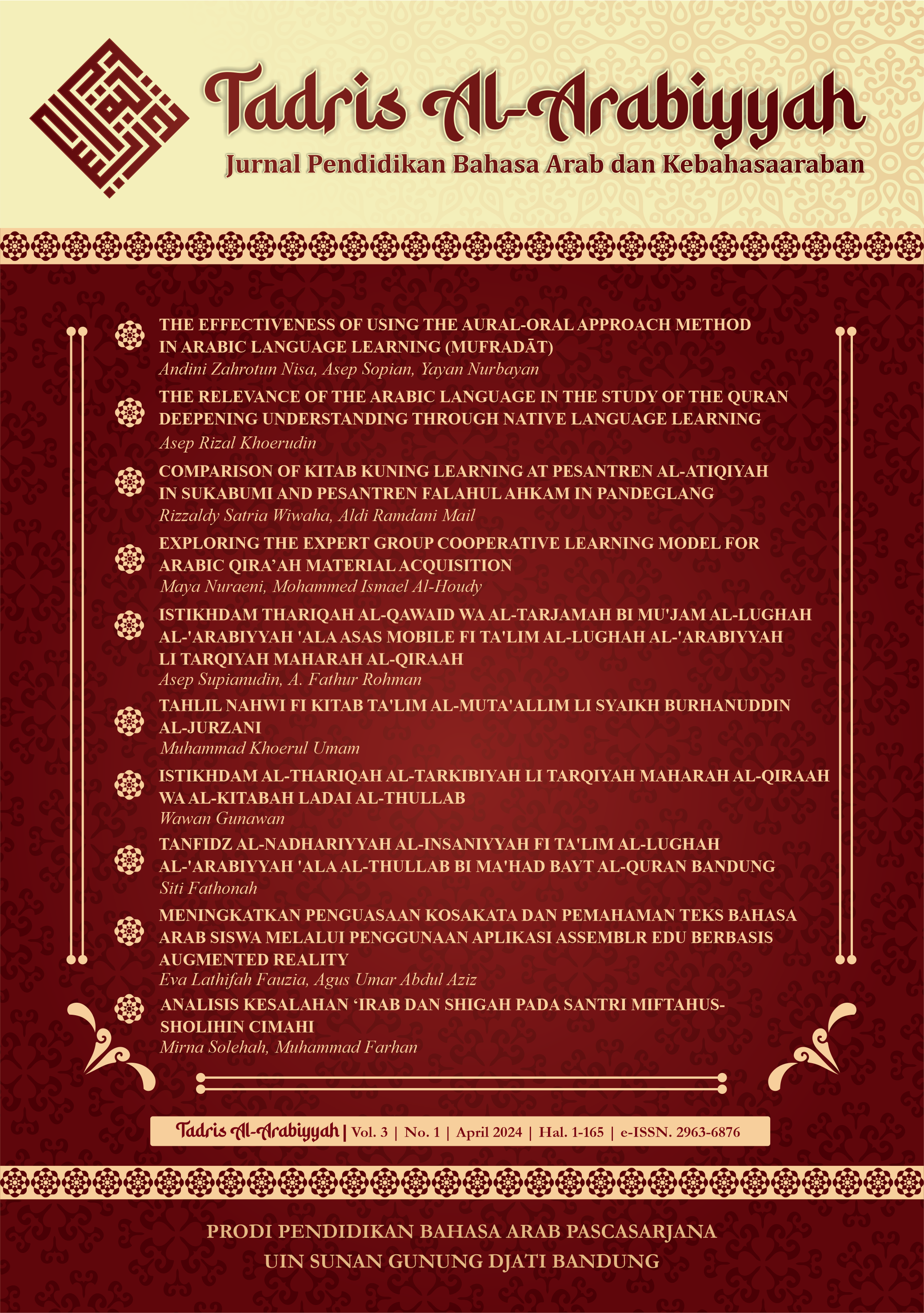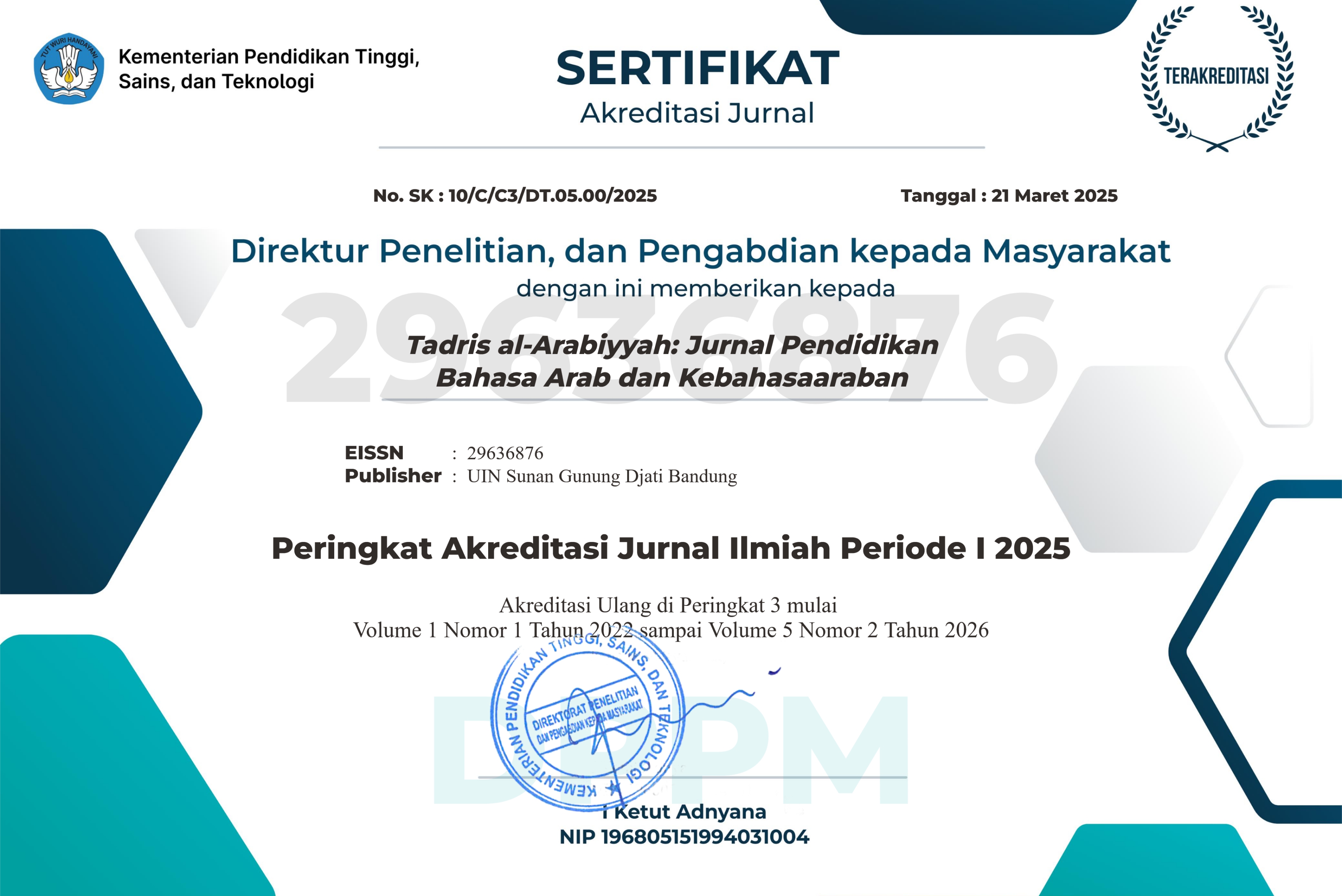The Effectiveness of Using the Aural-Oral Approach in Arabic Learning (MufradÄt)
DOI:
https://doi.org/10.15575/ta.v3i1.32039Abstract
Learning Arabic vocabulary (mufradÄt) often faces challenges in achieving effectiveness, particularly in motivating students to actively participate and deeply understand the material. Many conventional methods have significantly failed to improve students' listening and speaking skills. This study aims to analyze the effectiveness of using the Aural-Oral Approach in teaching Arabic vocabulary (mufradÄt). The Aural-Oral Approach, which emphasizes intensive listening and speaking skills, can enhance students' vocabulary acquisition in Arabic. This study was conducted at Madrasah Diniyah Takmiliyah (MDT) Ar-Rahman Bogor using a quantitative approach with a quasi-experimental design. The research sample consisted of 60 students divided into two groups: the experimental group using the Aural-Oral Approach and the control group using conventional methods. Data were collected through interviews and vocabulary tests before and after the intervention. The results of the data analysis showed a significant increase in Arabic vocabulary skills in the experimental group compared to the control group. This study's novelty lies in applying the Aural-Oral Approach in the context of Arabic language learning at the MDT level, which has not been extensively explored before. These findings indicate that the Aural-Oral Approach effectively improves Arabic vocabulary mastery. Therefore, it is recommended that this method be more widely implemented in Arabic language teaching to maximize student learning outcomes.
References
Afifah, N., Sunarto, S., Fauzi, M. F., Anindiati, I., & Nurdianto, T. (2020). The Implementation of Mimicry Memorization Method for Novice Students in Learning Arabic Mufradat. Jurnal Al Bayan: Jurnal Jurusan Pendidikan Bahasa Arab, 12(2), 263–280. http://dx.doi.org/10.24042/albayan.v12i2.5953
Alda, R. (2018). Podcasting Tasks and Students’ Aural-Oral Skills. International Journal of English and Education, 7(4), 244–251. Retrieved from https://ijee.org/assets/docs/19rivika.28065057.pdf
Ali, Q. M. S., Halimah, F. N., & Maryani, N. (2022). IstikhdÄm WasÄ«lah TadwÄ«r Al-Kurrah Fi Ta’lÄ«m Al-MufradÄt Al-‘Arabiyyah Wa Atsaruhu FÄ« Qudrah Al-TalÄmÄ«dz ‘AlÄ Al-HiwÄr Al-‘Arabi. Ta’lim al-’Arabiyyah: Jurnal Pendidikan Bahasa Arab & Kebahasaaraban, 6(1), 1–18. https://doi.org/10.15575/jpba.v6i1.16351
Al-Sobhi, B. M. S., & Preece, A. S. (2018). Teaching English speaking skills to the Arab students in the Saudi school in Kuala Lumpur: Problems and solutions. International Journal of Education and Literacy Studies, 6(1), 1–11. https://doi.org/10.7575/aiac.ijels.v.6n.1p.1
Anisa, A., Hermawan, A., Rifai, I., & Roostaei, Z. (2022). TathbÄ«q Al FÄ«diyÅ« Al Ta’lÄ«mÄ« Bi UslÅ«b SYIW (Sharing To Youtube, Instagram, And Whatsapp) Fi Ta’lÄ«m Al MufrÄdÄt Li Tarqiyah Istī’Äb Al TalÄmÄ«dz ‘Ala Ma’nÄhÄ. Ta’lim al-’Arabiyyah: Jurnal Pendidikan Bahasa Arab & Kebahasaaraban, 6(2), 255–270. https://doi.org/10.15575/jpba.v6i2.20608
Azizah, H. (2022). Implementation of Bithoqoh al-Mufradat Language Game Media (Vocabulary Cards) in Arabic Vocabulary Learning for Class V SDIT Al-Khairaat Yogyakarta. Jurnal Pendidikan LLDIKTI Wilayah 1 (JUDIK), 2(2), 74–79. https://doi.org/10.54076/judik.v2i02.262
Binos, P., Theodorou, E., Elriz, T., & Konstantopoulos, K. (2021). Effectiveness of Aural-Oral Approach Based on Volubility of a Deaf Child with Late-Mapping Bilateral Cochlear Implants. Audiology Research, 11(3), 373–383. https://doi.org/10.3390/audiolres11030035
Cholifah, N., & Akmalia, F. (2021). MahÄrah KalÄm Book: The Implementation at Arabic Course. ALSUNIYAT: Jurnal Penelitian Bahasa, Sastra, Dan Budaya Arab, 4(1), 1–14. https://doi.org/10.17509/alsuniyat.v4i1.27311
Fajriah. (2022). Pendekatan Aural Oral dalam Keterampilan Berbicara. FITRAH: International Islamic Education Journal, 4(1), 13–29. https://doi.org/10.22373/fitrah.v4i1.1984
Fajriah, Z. (2015). Peningkatan Penguasaan Kosakata Bahasa Arab (Mufradat) Melalui Penggunaan Media Kartu Kata Bergambar. Jurnal Pendidikan Usia Dini, 9(1), 107–126. https://doi.org/10.21009/JPUD.091.07
Hanani, N. (2020). Pembelajaran Bahasa Arab Kontemporer: Konstruksi Metodologis Pembelajaran Bahasa Arab Berbasis Komunikatif-Sosiolinguistik. CV Cendekia Press.
Hermawan, A. (2018). Metodologi Pembelajaran Bahasa Arab (Edisi Revisi). Remaja Rosdakarya.
Hijriyah, U., Zulhannan, Z., Nufus, Z., & Aridan, M. (2022). Pengembangan Media Strip Story Bergambar Terhadap Pembelajaran Mahârah Al-Kitâbah. Arabi : Journal of Arabic Studies, 7(2), 225–238. https://doi.org/10.24865/ajas.v7i2.490
Jaramillo, M. V. (2021). Developing Aural and Oral Skills of Beginner Learners of English as a Foreign Language Through Explicit Metacognitive Strategies Training. Latinoamericana de Estudios Educativos, 17(1), 120–141. https://doi.org/10.17151/rlee.2021.17.1.7
Khan, S. M., & Thayniath, S. (2020). Facilitating aural-oral skills of engineering students through the flipped classroom. Test Engineering and Management, 82(1–2), 154–167. Retrieved from https://testmagzine.biz/index.php/testmagzine/article/view/964/871
Liu, X., Zhang, L., Zhang, S., & Tian, Y. (2020). The Further Study of the Blended Learning Model of the Video-Aural-oral Course Combination of Web-based Learning, Flipped Classroom and Face-to-face Instruction. Education Journal, 9(3), 64–72. https://doi.org/10.11648/j.edu.20200903.12
Lotfi-Khajouei, M., Baharlooei, R., Salehi, H., & Tabatabaei, O. (2022). Impact of Multiple Intelligence-Based Activities (MIBAs) on the Improvement of Male and Female EFL Students’ Aural-Oral Performance. Argentinian Journal of Applied Linguistics-ISSN 2314-3576, 10(1), 79–94. Retrieved from https://ajal.faapi.org.ar/ojs-3.3.0-5/index.php/AJAL/article/view/51
Mauladi, A. D., Hunafa, M. H., Hakim, R. M., & Putra, Y. R. (2018). Teaching the Arabic Language by the Mean of Soft and Aural-Oral Approach. Proceeding of International Conference on Islamic Education, 1(1), 5–15. https://doi.org/10.51425/icie.vi.19
Mitrajati, K., Zaini, H., & Holilulloh, A. (2023). Acquisition of Arabic Vocabulary Through the Book Al-‘Arabiyyah Baina Yadaik (I) in Foreign Language Course Institutions. Scaffolding: Jurnal Pendidikan Islam Dan Multikulturalisme, 5(2), 1001–1014. https://doi.org/10.37680/scaffolding.v5i2.3407
Mohammed, W. S. E.-K., & Muhy, R. (2021). Improving Saudi EFL Students’ Aural Oral Skills. International Journal of English Language and Linguistics Research, 9(7), 19–31.Retrieved from https://ssrn.com/abstract=3922080
Najib, A. A. (2021). Meningkatkan Keterampilan Menyimak dalam Pembelajaran Bahasa Arab Siswa dengan Metode Aural Oral Approach. Teaching: Jurnal Inovasi Keguruan Dan Ilmu Pendidikan, 1(3), 236–244. https://doi.org/10.51878/teaching.v1i3.538
Nurkholis, F., & Munawwaroh, E. I. (2021). Pendekatan Aural-Oral Approach Dalam Keterampilan Berbahasa Arab. Al-Mu’arrib: Journal Of Arabic Education, 1(1), 1–11. https://doi.org/10.32923/al-muarrib.v1i1.2059
Permana, I., Rohanda, R., & Ruhendi, A. (2023). Ansyithah Al-Thalabah fÄ« Istī’Äb Al-MufradÄt wa Al-MuhÄdlarah wa ‘AlÄqatuhÄ Biqudratihim ‘AlÄ Al-MuhÄdatsah Al-‘Arabiyyah. Tadris Al-’Arabiyyah: Jurnal Pendidikan Bahasa Arab Dan Kebahasaaraban, 2(1), 53–65. https://doi.org/10.15575/ta.v2i1.24402
Pourkalhor, O., & Esfandiari, N. (2017). Culture in Language Learning: Background, Issues and Implications. Language, 5(01), 23–32. Retrieved from http://www.eltsjournal.org/archive/value5%20issue1/4-5-1-17.pdf
Rahmah, K. (2023). Penerapan Pendekatan Aural-Oral Approach dengan Metode Suggestopedia pada Pembelajaran Bahasa Arab Kelas IV MI Al-Muhajirin Banjarmasin Timur [Skripsi, UIN Antasari Banjarmasin]. Retrieved from https://idr.uin-antasari.ac.id/25749/
Richards, J. C., & Rodgers, T. S. (2014). Approaches and Methods in Language Teaching. Cambridge University Press.
Rivers, W. M. (2018). Teaching Foreign Language Skills. University of Chicago Press.
Saepurrohman, A., & Nurhayati, S. L. (2020). IstikhdÄm UslÅ«b Al GhinÄ FÄ« Ta’lÄ«m Al MufradÄt Al ‘Arabiyyah Li Tarqiyati Qudrah Al TalÄmÄ«dz ‘AlÄ AlhiwÄr Al ‘ArabÄ«. Ta’lim al-’Arabiyyah: Jurnal Pendidikan Bahasa Arab & Kebahasaaraban, 3(2), 175–193. https://doi.org/10.15575/jpba.v3i2.7715
Satori, A., Suparno, D., Assyauqi, A., Wahidah, W., Anas, M., Rokhim, M. F., & Zakaizak, F. M. F. (2023). Linguistic Discoveries: Tracing Grammatical Errors in the Translation of Qasas Al-Nabiyyīn by Abu Hasan Ali Hasani Nadwi. Ta’lim al-’Arabiyyah: Jurnal Pendidikan Bahasa Arab & Kebahasaaraban, 7(2), 236–249. https://doi.org/10.15575/jpba.v7i2.26666
Sujariati, S. (2020). Improving the Student's Listening Comprehension through Aural-Oral Language Approach. Linguistic, English Education and Art (LEEA) Journal, 3(2), 486–505. https://doi.org/10.31539/leea.v3i2.1253
Suleiman, Y. (2019). Arabic Language and National Identity: A Study in Ideology. Edinburgh University Press.









